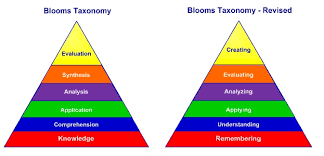Bloom's Taxonomy
Bloom's Taxonomy is a tiered system of classifying thinking. It has six different levels, and there are two versions of it. One version of the taxonomy is the one on the left in the picture, and this version was created by Bloom himself in 1956.
Bloom created the taxonomy to help educators and ways to classify goals and objectives for students. The taxonomy tiers are structured so that if you get to the analysis, you have understood and mastered the three lower levels. The three lower levels of taxonomy are knowledge, comprehension, and application. The three higher levels are analysis, synthesis, and evaluation.
In the 1990s, a former student of Bloom's went back and looked at his taxonomy levels and revised/updated the taxonomy. The student wanted to bring the taxonomy levels to modern education, so it had to be modernized. Like Bloom, this student spent years working and revising these levels before publishing them.
The most noticeable change in the taxonomy is the words; Bloom's student changed them from nouns to verbs. Also, knowledge was changed to remembering, and comprehension and synthesis were changed to understanding and creating. The picture on the right has the revisions.
Simple definitions to define the new terms would be: remembering is a recall from long-term memory, understanding is summarizing or classifying, applying is implementing, analyzing is breaking the material into parts and then determining its purpose through a new structure, evaluating is making judgments through critique, creating is putting elements together to form a cohesive whole.
Personally, I enjoy Bloom's taxonomy. I feel that it is a way to see if your students genuinely comprehend material throughout complete units and lessons. So, even before giving students a project or assessment, you as a teacher can see if they understood all information they were taught throughout the unit.

Comments
Post a Comment